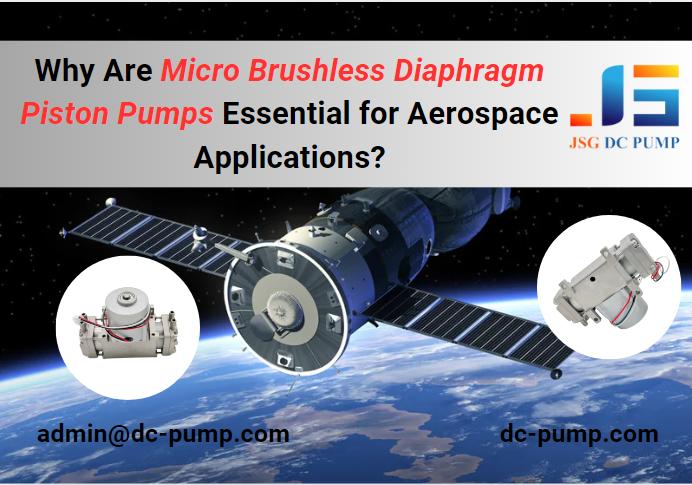
Table of Contents
- Introduction
- Challenges in Aerospace Fluid Control Systems
- Why Micro Brushless Diaphragm Piston Pumps?
- How Are These Pumps Used in Aerospace?
- Key Challenges in Space Applications
- Optimization Strategies for Future Space Missions
- Conclusion
Introduction
The advancement of space exploration has increased the demand for reliable and efficient fluid control systems. Every aerospace mission, from satellites to crewed spacecraft, depends on precise fluid management for propulsion, cooling, life support, and scientific research. As missions extend in duration and complexity, fluid control technology must adapt to extreme space conditions.
Many conventional pumps struggle in space due to mechanical wear, leakage, and high energy consumption. Since maintenance in space is nearly impossible, aerospace engineers require fluid control systems that offer durability, energy efficiency, and precision.
Micro brushless diaphragm piston pumps have emerged as a promising solution. By integrating diaphragm and piston mechanisms with a brushless motor, these pumps offer compact size, precision, and longevity. This article explores their working principles, advantages, applications, and strategies for optimizing their performance in space environments.
Challenges in Aerospace Fluid Control Systems
Fluid management in space presents significant technical challenges, requiring specialized solutions:
- Microgravity Effects– Fluids behave differently in space, making traditional pumps less effective. Aerospace pumps must function without gravity-assisted flow.
- Extreme Temperatures– Spacecraft experience temperatures ranging from -150°C to over 150°C, requiring pumps that can withstand severe fluctuations.
- Vacuum Conditions– The absence of atmospheric pressure alters fluid behavior and affects mechanical performance.
- Radiation Exposure– Cosmic radiation degrades electronic components and materials over time.
- Weight and Energy Efficiency– Reducing weight is critical for mission success. Pumps must be lightweight and consume minimal power.
- Long-Term Reliability– Space missions last for years, requiring pumps with minimal wear and no maintenance.
Selecting the right fluid control technology is essential for mission success.
Why Micro Brushless Diaphragm Piston Pumps?
These pumps offer a compact, precise, and energy-efficient solution to aerospace fluid control challenges. Their advantages include:
- Long operational lifespan due to brushless motor technology.
- Accurate and pulsation-free fluid delivery.
- Leak-proof and contamination-free operation.
- Compact and lightweight design.
- Reliable performance in vacuum environments.
These features make them suitable for various aerospace applications, including propulsion, cooling, and life support.
How Are These Pumps Used in Aerospace?
1. Propulsion Systems
Precise control of fuel and oxidizer flow is essential for propulsion. These pumps:
- Regulate propellant mixing for improved combustion.
- Enable precise thrust adjustments for spacecraft maneuvering.
- Support attitude control thrusters for trajectory corrections.
2. Thermal Control Systems (TCS)
Managing spacecraft temperature is crucial to prevent overheating. These pumps:
- Circulate cooling fluids efficiently.
- Operate in extreme temperature environments.
- Reduce energy consumption while maintaining system stability.
3. Life Support and Environmental Control
For crewed missions, air and water management is essential. These pumps:
- Facilitate air circulation and CO₂ scrubbing.
- Enable oxygen delivery and gas regulation.
- Support water recycling for long-duration missions.
4. Scientific Research and Laboratory Systems
Many space-based experiments require precise fluid handling. These pumps:
- Deliver controlled fluid flow for biological and chemical research.
- Maintain contamination-free transfers in laboratory conditions.
- Support automated reagent mixing and sample preparation.
Their versatility makes them essential for modern aerospace missions.
Key Challenges in Space Applications
Despite their benefits, these pumps must be engineered for long-term operation. Key challenges include:
- Minimizing weight while maintaining performance.
- Enhancing resistance to mechanical wear.
- Protecting electronics from radiation.
- Optimizing performance in zero gravity.
Addressing these challenges ensures reliable operation in extreme environments.
Optimization Strategies for Future Space Missions
To improve performance, engineers focus on several key areas:
1. Advanced Materials and Manufacturing
- Lightweight aerospace-grade alloys reduce overall mass.
- Corrosion-resistant coatings enhance durability.
2. Smart Control Systems
- Real-time sensor feedback optimizes pump performance.
- AI-based maintenance prediction helps prevent failures.
3. Modular and Scalable Designs
- Interchangeable pump components allow for flexibility.
- Multi-purpose pumps reduce the need for redundant systems.
Implementing these strategies ensures that pumps continue to meet the demands of future space missions.
Conclusion
Micro brushless diaphragm piston pumps provide precise and efficient fluid control for aerospace applications. Their role in propulsion, cooling, life support, and scientific research makes them an essential component of modern space missions.
As space technology advances, further improvements in materials, control systems, and system integration will ensure these pumps continue to support mission-critical operations.
At JSG DC PUMP, we specialize in developing high-performance micro pump solutions for aerospace, medical, and industrial applications. With over 22 years of R&D experience, we provide customized, reliable micro pumps that meet the most demanding industry standards.
For inquiries, contact admin@dc-pump.com or visit dc-pump.com.




